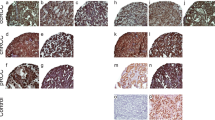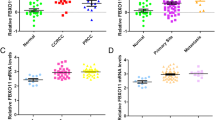Abstract
Frequency and mortality of renal cell carcinoma (RCC) are increasing for decades. However, the molecular background of RCC tumorigenesis is still poorly understood. In current study we investigated the expression of TCF/LEF and SFRP family members (SFRP1 and SFRP3) to gain a better understanding of biological signaling pathways responsible for epidemiology and clinical parameters of clear cell RCC (cRCC). Thirty-six pairs of paraffin-embedded clear cRCC and adjacent nontumoral tissues samples using immunohistochemistry (IHC) were analyzed and compared with corresponding clinicopathological parameters. Immunohistochemistry indicated statistically significant decreased SFRP3 expression in tumor tissues but no consistency in SFRP1 expression in analyzed normal and tumor tissue. The TCF1 expression level was significantly weaker in normal tissue compared to tumor samples while LEF1 protein levels were significantly weaker in tumor tissue. To our knowledge, this is the first report on analysis of the expression of transcription factors TCF1 and LEF1 in clear cell renal cell carcinoma and their comparison with Wnt signal pathway antagonists belonging to SFRP family.





Similar content being viewed by others
References
Moon RT, Kohn AD, De Ferrari GV, Kaykas A (2004) WNT and h-catenin signaling: diseases and therapies. Nat Rev Genet 5:691–701
Nelson WJ, Nusse R (2004) Convergence of Wnt, h-catenin, and cadherin pathways. Science 303:1483–1487
Waterman ML (2004) Lymphoid enhancer factor/T cell factor expression in colorectal cancer. Cancer Metastasis Rev 23:41–52
Schilham MW, Clevers H (1998) HMG box containing transcription factors in lymphocyte differentiation. Semin Immunol 10:127–132
Brantjes H, Barker N, van Es J, Clevers H (2002) TCF: Lady Justice casting the final verdict on the outcome of Wnt signalling. Biol Chem 383:255–261
Reya T, Clevers H (2005) Wnt signalling in stem cells and cancer. Nature 434:843–850
Logan CY, Nusse R (2004) The Wnt signaling pathway in development and disease. Annu Rev Cell Dev Biol 20:781–810
Dennis S, Aikawa M, Szeto W, d’Amore PA, Papkoff J (1999) A secreted frizzled related protein, FrzA, selectively associates with Wnt-1 protein and regulates wnt-1 signaling. J Cell Sci 112:3815–3820
Uren A, Reichsman F, Anest V, Taylor WG, Muraiso K, Bottaro DP, Cumberledge S, Rubin JS (2000) Secreted frizzled related protein-1 binds directly to Wingless and is a biphasic modulator of Wnt signaling. J Biol Chem 275:4374–4382
Caldwell GM, Jones C, Gensberg K, Jan S, Hardy RG, Byrd P, Chughtai S, Wallis Y, Matthews GM, Morton DG (2004) The Wnt antagonist sFRP1 in colorectal tumorigenesis. Cancer Res 64:883–888
Weibel ER (1979) Stereological methods, vol. 1, practical methods for biological morphometry. Academic, London, pp 1–415
Wicksell SD (1925) The corpuscle problem. A mathematical study of a biometric problem. Biometrika 17:84–99
Wicksell SD (1926) The corpuscle problem. Second memoir. Case of ellipsoidal corpuscles. Biometrika 18:151–172
Shi Y, He B, You L, Jablons DM (2007) Roles of secreted frizzled-related proteins in cancer. Acta Pharmacol Sin 28(9):1499–1504
Gumz ML, Zou H, Kreinest PA, Childs AC, Belmonte LS, LeGrand SN, Wu KJ, Luxon BA, Sinha M, Parker AS, Sun LZ, Ahlquist DA, Wood CG, Copland JA (2007) Secreted frizzled-related protein 1 loss contributes to tumor phenotype of clear cell renal cell carcinoma. Clin Cancer Res 13:4740–4749
Dahl E, Wiesmann F, Woenckhaus M, Stoehr R, Wild PJ, Veeck J, Knüchel R, Klopocki E, Sauter G, Simon R, Wieland WF, Walter B, Denzinger S, Hartmann A, Hammerschmied CG (2007) Frequent loss of SFRP1 expression in multiple human solid tumours: association with aberrant promoter methylation in renal cell carcinoma. Oncogene 26:5680–5691
Awakura Y, Nakamura E, Ito N, Kamoto T, Ogawa O (2008) Methylation-associated silencing of SFRP1 in renal cell carcinoma. Oncol Rep 20:1257–1263
Rubin JS, Barshishat-Kupper M, Feroze-Merzoug F, Xi ZF (2006) Secreted WNT antagonists as tumor suppressors: pro and con. Front Biosci 11:2093–2105
Saini S, Liu J, Yamamura S, Majid S, Kawakami K, Hirata H, Dahiya R (2009) Functional significance of secreted frizzled-related protein 1 in metastatic renal cell carcinomas. Cancer Res 69(17):6815–6822
Joesting MS, Perrin S, Elenbaas B, Fawell SE, Rubin JS, Franco OE, Hayward SW, Cunha GR, Marker PC (2005) Identification of SFRP1 as a candidate mediator of stromal-to-epithelial signaling in prostate cancer. Cancer Res 65(22):10423–10430
Peichel CL, Kozak CA, Luyten FP, Vogt TF (1998) Evaluation of mouse Sfrp3/Frzb1 as a candidate for the lst, Ul, and Far mutants on chromosome 2. Mamm Genome 9(5):385–387
Zi X, Guo Y, Simoneau AR, Hope C, Xie J, Holcombe RF, Hoang BH (2005) Expression of Frzb/secreted Frizzled-related protein 3, a secreted Wnt antagonist, in human androgen-independent prostate cancer PC-3 cells suppresses tumor growth and cellular invasiveness. Cancer Res 65(21):9762–9770
Pećina-Slaus N, Nikuseva Martić T, Deak AJ, Zeljko M, Hrasćan R, Tomas D, Musani V (2010) Genetic and protein changes of E-cadherin in meningiomas. J Cancer Res Clin Oncol 136(5):695–702
Hirata H, Hinoda Y, Ueno K, Majid S, Saini S, Dahiya R (2010) Role of secreted frizzled-related protein 3 in human renal cell carcinoma. Cancer Res 70(5):1896–1905
Lustig B, Behrens J (2003) The Wnt signaling pathway and its role in tumor development. J Cancer Res Clin Oncol 129(4):199–221
van de Wetering M, Cavallo R, Dooijes D, van Beest M, van Es J, Loureiro J, Ypma A, Hursh D, Jones T, Bejsovec A, Peifer M, Mortin M, Clevers H (1997) Armadillo coactivates transcription driven by the product of the drosophila segment polarity gene dTCF. Cell 88(6):789–799
Conflict of interest
I hereby certify absence of actual or potential conflict of interest in relation to this article.
Author information
Authors and Affiliations
Corresponding author
Rights and permissions
About this article
Cite this article
Nikuševa-Martić, T., Šerman, L., Zeljko, M. et al. Expression of Secreted Frizzled-Related Protein 1 and 3, T-cell Factor 1 and Lymphoid Enhancer Factor 1 in Clear Cell Renal Cell Carcinoma. Pathol. Oncol. Res. 19, 545–551 (2013). https://doi.org/10.1007/s12253-013-9615-3
Received:
Accepted:
Published:
Issue Date:
DOI: https://doi.org/10.1007/s12253-013-9615-3




